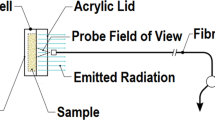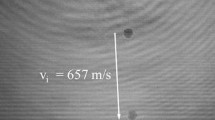Abstract
A physically based model for the shock Hugoniot of a powdered material is described which allows separate identification of the cold and thermal contributions to pressure and specific internal energy. Special features of this model are provision for the effects of porosity on the stress state and an empirically determined cold loading contribution to pressure. The model was tested against published Hugoniot data for iron and gave excellent agreement for shock pressures ranging from low to high values.
This shock Hugoniot was used to explore the shocked state of 4 samples of iron powder derived from commercially available material. The purpose of this study was to investigate the effect of powder particle characteristics and initial starting densities on the shocked state.
The powder samples investigated had a range of morphologies and sizes. Powders with either a large shape factor or high internal friction, as determined in shear cell experiments, exhibited a higher stiffness in the cold loading curve. In the shocked state, this translated into a higher cold component of pressure and energy than found in the other powders.
The effect of initial powder density was studied by applying the Hugoniot model to two impact initiated shock loadings, one for a stainless steel flyer impacting at 0.5 km/s and one at the higher velocity of 2.0 km/s. Both were applied to iron powder targets preloaded to a range of initial densities. For a given impact event, the proportion of shock energy in the thermal mode was found to decrease with increasing initial density. This decrease was more pronounced at higher shock strengths. As a result of the decreasing component of thermal energy with higher initial density, there was a reduction in the continuum temperature behind the shock. However, the corresponding increase in the component of cold energy with the falling relative contribution from the thermal energy lead to increasing density behind the shock suggesting that there is a trade off in terms of temperature and density achievable with a given impact event.
Similar content being viewed by others
References
Boade RR (1970) Principal Hugoniot, second-shock Hugoniot and release behavior of pressed copper powder. J Appl Phys 41:4542
Bocksteigel G, Hewing J (1965) Critical review of the literature on the densification of powders in rigid dies. Archiv Eisenhüttenwesen 36:751
Carr JF, Walker DM (1968) An annular shear cell for granular materials. Powd Tech 1:369
Jenike AW (1964) Storage and flow of solids. Bull. No. 123 Utah Eng. Exp. Station Univ. of Utah
Kawakita K, Lüdde K-H (1970) Some considerations on powder compression equations. Powd Tech 4:61
Kondo K, Sawai S (1990) Fabricating nanocrystalline diamond ceramics by a shock compaction method. J Amer Ceram Soc 73:1983
Krueger BR, Vreeland T Jr. (1992) Shock-initiated chemical reactions in 1:1 atomic percent nickel-silicon powder mixtures. In: Meyers MA, Murr LE, Staudhammer KP (eds) Shock-wave and high-strain-rate phenomena in materials. Marcel Dekker, NY, pp 245–252
Lynse PC, Halpin JC (1968) Shock compression of porous iron in the region of incomplete compaction. J Appl Phys 39:5488
Marsh SP (ed) (1980) LASL shock Hugoniot data. Univ. of California, Berkeley
Meyers MA, Murr LE, Staudhammer KP (eds) (1992) Shock-wave and high-strain-rate phenomena in materials. Marcel Dekker, NY, Sect. 2
Morris DG (1981) Melting and solidification during dynamic powder compaction of tool steel. Metal Science 15:116
Page NW, Killen PD, St John DH (1990) Sintering enhancement in dynamically compacted commercial iron powders. Materials Science and Engineering A 130:231
Page NW, Warpenius MK (1990) Loading relations for metal powders pressed to high density. Powd Tech 61:87
Page NW, Yousuff M, Wauchope CJ (1993) Interparticle friction in granular ceramic materials. KONA: Powder and Particle 11:147
Petrie MW (1991) The shock compaction of powdered materials with special reference to Neodymium-Boron-Iron. Thesis, M Eng Sc, The University of Queensland
Petrie MW, Page NW (1991) An equation of state for shock loaded powders. J Appl Phys 69:3517
Raybould D (1981) The properties of stainless steel compacted dynamically to produce cold interparticle welding. J Materials Science 16:589
Schwartz RB, Kasiraj P, Vreeland T Jr., Ahrens TJ (1984) A theory for the shock-wave consolidation of powders. Acta Metall 32:1243
Schwartz RB, Kasiraj P, Vreeland T Jr. (1986) Temperature kinetics during shock-wave consolidation of metallic powders. In: Murr LE, Staudhammer KP, Meyers MA (eds) Metallurgical applications of shock-wave and high strain rate phenomena. Marcel Dekker, NY, pp 313–327
Simons GA, Legner HH (1982) An analytic model for the shock Hugoniot in porous materials. J Appl Phys 53:943
Sonntag RE, Van Wylen GJ (1966) Statistical thermodynamics. Wiley, NY, p 190
Underwood EE (1970) Quantitative stereology. Addison-Wesley, Reading Mass., p 25
Williamson RL, Berry RA (1985) In: The fourth APS topical conference on shock waves in condensed matter, July 22–25, 1985, Spokane. Plenum Press, NY
Yousuff M (1991) Measurement of powder characteristics and their influence on the die stress in quasi-static and dynamic powder compaction. Thesis, M Eng Sc, The University of Queensland
Yousuff M, Page NW (1993a) Particle material, morphology and load effects on internal friction in powders. Powder Technology 76:155
Yousuff M, Page NW (1993b) Die stress and internal friction during quasistatic and dynamic powder compaction. Powder Technology 76:299
Zel'dovich YB, Raizer YP (1967) Physics of shock waves and high-temperature hydrodynamic phenomena, Vol II. Academic Press, New York, p 697
Author information
Authors and Affiliations
Additional information
This article was processed using Springer-Verlag TEX Shock Waves macro package 1.0 and the AMS fonts, developed by the American Mathematical Society.
Rights and permissions
About this article
Cite this article
Page, N.W. Particle morphology and packing effects on the shock loading of powders. Shock Waves 4, 73–80 (1994). https://doi.org/10.1007/BF01418570
Received:
Accepted:
Issue Date:
DOI: https://doi.org/10.1007/BF01418570




